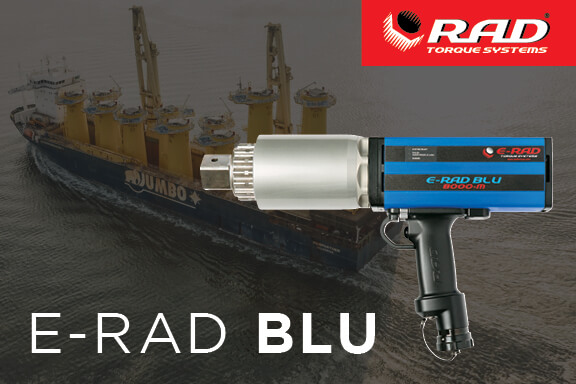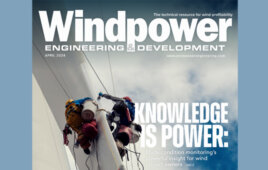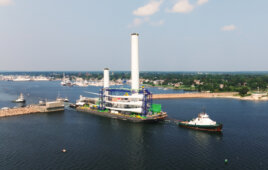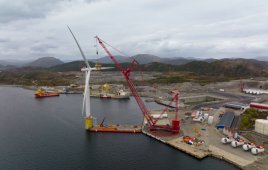The potential for unlimited generation of clean, renewable energy makes offshore wind turbines a modern choice for global power production.
While there are many benefits to offshore wind turbines, building them at sea poses some unique challenges during the transport and construction process. Construction at sea is a demanding task, and transporting the immense components required for offshore wind turbines safely and efficiently requires special consideration.
As a result, specialized seagoing vessels such as those provided by Jumbo, a leading heavy lift shipping and offshore transport and installation contractor, are required to transport the materials. Seagoing vessels require costly time at port, so the company is always looking for efficiencies during the load process before heading out to sea.
Jumbo transports transition pieces offshore
Recently, Jumbo took on a contract to transport offshore wind turbine components, including transition pieces, to the construction site of a new overseas offshore wind farm. Specialized ships from Jumbo’s heavy lift vessel fleet were employed to transport the transition pieces used in the construction of the wind turbine.
 Each transition piece is like a massive steel tube and is, on average, about 25-m high and weighs about 500 tonnes. It sits on top of the monopile, or foundation, and links it to the turbine tower. The transition piece often includes special attachments such as boat landings and ladders on its exterior, essential for the construction and maintenance of the turbines. However, these extra attachments can make it even more challenging to transport, so customized equipment is necessary. As this was a large job with many pieces requiring transport, the company needed to consider practical ways to reduce the load time of their vessels and the resulting time in port.
Each transition piece is like a massive steel tube and is, on average, about 25-m high and weighs about 500 tonnes. It sits on top of the monopile, or foundation, and links it to the turbine tower. The transition piece often includes special attachments such as boat landings and ladders on its exterior, essential for the construction and maintenance of the turbines. However, these extra attachments can make it even more challenging to transport, so customized equipment is necessary. As this was a large job with many pieces requiring transport, the company needed to consider practical ways to reduce the load time of their vessels and the resulting time in port.
“Jumbo has very large ships in their heavy lift vessel fleet that are used to handle the transport of these transition pieces,” explained Diederik Bekkering, commercial director at RAD Torque Systems B.V. “The pieces need to be ‘seafastened’ or locked onto the ship’s deck to ensure they don’t get damaged during the shipment. The vessels are specially constructed with a steel structure that the transition piece falls into. It’s locked with big bolts and those bolts keep the transition piece fastened during the sea voyage.
“As you can imagine, these specialized ships are extremely expensive, so the minimum amount of time they spend in the port, the better,” continued Bekkering. “When in port, the main activity is hoisting a transition piece onto the ship, seafastening it, then moving to the next one. It’s during this procedure that we look for ways to create efficiencies and speed up this process.”
This is where the power of a RAD Torque tool will make a significant difference. “On this last job, the Jumbo crew used the RAD Torque Systems E-RAD BLU 10K for the seafastening process. The results they found were incredible. A job that used to take an hour with a hydraulic wrench now was reduced to 20 minutes using the E-RAD BLU torque wrench,” explained Bekkering.
Using RAD Torque to save time in port
“When you’re in port, waiting for the crane to load the next item, and a crewman is asking when you’re ready to continue, you’re looking for time savings,” Bekkering said. “And time savings works out to cost savings. Any time savings in your critical time path works out very well economically on your spreadsheets. If you can reduce the time you’re in port from, say, 48 hours to 24 hours, that is a major advantage.”
Using the RAD Torque tools for this project saved an estimated €50K a day as Jumbo was able to complete the job sooner and reduce the time in port. “The return on your investment in RAD Torque tools is immediate,” explained Bekkering.
“Previously, Jumbo used a hydraulic wrench for their seafastening of the transition pieces while in port. Moving to the E-RAD BLU from the slower hydraulic was like going from riding a bicycle to taking a high-speed train — the time savings are that significant.”
Beyond the time savings, there are many other inherent advantages to using a RAD Torque tool over a hydraulic wrench. RAD Torque tools are accurate, lightweight, quiet, and designed with the worker in mind.
“With a hydraulic wrench, you need to take time to set it up on the job site. You can’t waste that time in port,” said Bekkering. “The E-RAD BLU is plug and play. Plug it in, punch in the torque you need, and you’re on the job immediately.” The complete setup for the E-RAD BLU is also much more compact, making it a better choice for the small spaces that the workers sometimes need to work in.
Safety is a huge consideration when making the shift to a RAD Torque wrench from a hydraulic. A torque wrench has no risk of oil leakage or spillage, which can cause several hazards on deck. With no hose, the trip hazard is eliminated as well. Designed to be much more lightweight than its hydraulic counterpart, the E-RAD BLU is ergonomic and easier to handle, reducing fatigue by the user and helping to contribute to the efficiency of the tool.
“The feedback that we’ve received from our customer has been overwhelmingly positive,” said Bekkering. “Being able to get an accurate torque reading has been a game-changer for them.” The precision torque and high degree of accuracy offered by the E-RAD BLU, when combined with the Bluetooth compatibility for data logging and verified joint calibration, make this the tool of choice for many applications across a myriad of industries.
“Jumbo is looking forward to using the E-RAD going forward on future contracts and continuing to recognize both time and cost savings,” concluded Bekkering.
It’s clear that offshore wind power generation is a move to the future, with offshore wind production to reach 11-times the projected global electricity demand in 2040, according to the International Energy Agency. The demand for greater efficiencies in the construction and maintenance of these wind farms will only increase, so looking to the innovation of leaders like RAD Torque Systems and others in the industry becomes even more important as we pursue our goal of clean power worldwide.
This case study was contributed by RAD Torque Systems
Filed Under: Featured




